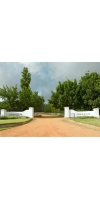Wine from Rhebokskloof

The Rhebokskloof Estate
Rhebokskloof dates back to 19 August 1692, when Simon van der Stel, then governor of the Cape, awarded a free grant of land to Dirk van Schalkwyk. The initial large piece of land was divided into six different farms between the First and Second World Wars, and sold off.
The original farm was only reclaimed in 1986, when new owners bought back the other five farms. An early dwelling on the farm built around 1692 has since been restored as the main homestead. A later dwelling is dated 1797, and is built in the traditional Cape Dutch style, and has also been restored to its former splendor.
Rhebokskloof’s current owners bought the estate in 2006.
The Rhebokskloof Cellar and the Winemaker
Rhebokskloof’s winemaker, Rolanie Lotz, studied cellar technology at Elsenburg Agricultural College in Stellenbosch and joined Rhebokskloof in 2007 after being winemaker at Simonsvlei for four years. Her career highlight thus far has been winning a gold medal and fifth place overall for Rhebokskloof 2007 Black Marble Syrah at the 2010 Syrah du Monde wine competition in France. Rolanie’s passion for Shiraz and her unique winemaking skills is reflected in our award-winning wines.
Rhebokskloof’s cellar makes use of traditional techniques when creating wine, forgoing extensive technology for time-trusted approaches that yields exceptional wine. During the pump-over process in harvest time, some of the grapes are pressed by hand.
The cellar is focused on biodiversity and creates an eco-friendly culture through initiatives like using ‘tree-free’ wine labels. Rhebokskloof is the first South African wine estate to use labels made from 100% renewable sugar cane fibre that are completely wood-free.
The Rhebokskloof Vineyards
Karin Louw is Rhebokskloof’s viticulturist. She studied cellar technology at Elsenburg Agricultural College in Stellenbosch and then gained experience abroad, working in France and New Zealand. She has been working at Rhebokskloof since 2007, first as assistant winemaker and since 2010 as viticulturist. One of her career highlights at Rhebokskloof was being instrumental in the vineyard replanting program on the estate.
No products found
- back
Selected Options
Wineries
Categories
Pricing
Countries
Regions
Grape Types
Wineries
Organic/Free Shipping
Domaine Jean Grivot Echezeaux Grand Cru is made from 100 percent Pinot Noir.
Domaine Jean Grivot is among the great names in Burgundian wine. Étienne Grivot and his wife Marielle took over from Étienne’s father Jean Grivot in 1987. The vineyards are densely planted and farmed organically “sans certification” while the aim in the cellar is for balance and clear expression of terroir.
Jean Grivot’s 15.5 hectares spread across 22 appellations with vineyards in the communes of Vosne-Romanée, Vougeot, Chambolle-Musigny, and Nuits-Saint-Georges. Besides the three grand crus, there are 8 premier crus including the much lauded Les Beaux Monts and Suchots in Vosne-Romanée. The grapes are completely de-stemmed and fermentation is spontaneous.
About the Vineyard:
Echézeaux grand cru is a large vineyard of 38 hectares divided into 11 individual climats. Grivot’s parcel is in the climat of Les Cruots and lies at the southern end of Echézeaux near the premier cru of Les Suchots. A good Echézeaux should have rich fruit, considerable earthiness, and be very complete on the palate.
Tasting Notes:
The wine shows aromas and flavors of red berries, herbs, and purple flowers. The palate is rich with ripe fruit and medium weight with bright acidity and fine tannins. Aging in 40-70% new Burgundian pièce brings notes of vanilla, toast, and baking spices.
Food Pairing:
Red Burgundy might be the world’s most flexible food wine. The wine’s high acidity, medium body, medium alcohol, and low tannins make it very food-friendly. Red Burgundy, with its earthy and sometimes gamey character, is a classic partner to roasted game birds, grilled duck breast, and dishes that feature mushrooms, black truffles, or are rich in umami.
Review:
A very elegant expression of Echezeaux, with a velvety black plum and rose petal fruit. There is a lovely freshness and so much finesse that the tannin and structure might surprise you at the end. This has the substance to age for decades. Produced from a 0.84ha parcel in Cruots next to Comte Liger-Belair. The vines were planted in 1954 and the destemmed fruit was gently fermented.
This is pure, racy and enticing, hosting aromas and flavors of black currant, blackberry, violet and iron. This is about finesse, grace and precision balance, with saturated fruit flavors persisting on the superlong aftertaste. Needs a decade in the cellar.
-Wine Spectator 97 Points
Corinne Perchaud Chablis 1er Cru Fourchaume is made from 100 percent Chardonnay
Elegant citrus aromas. Concentrated and finessed, combining flavors of dried fruit with slight hints of woody notes. Perfect balance between body and acidity, long and persistent finish. This one is drinking great now, but as with all exceptional Chablis, it is possible to pay it down for years to come.
Made from 35 year old vines. The owners take great care to produce exceptional Chablis wine by keeping the lively Chardonnay fruit and the unique mineral quality imparted by the Kimmeridgian soil, the fruity acidity and bouquet in perfect balance. The grapes are harvested by hand and gently pressed in a horizontal pressoir to ensure the fullest extraction and range of flavors and aromas.
Pair with Scallops Jacques cream, roast veal with oyster mushrooms.




